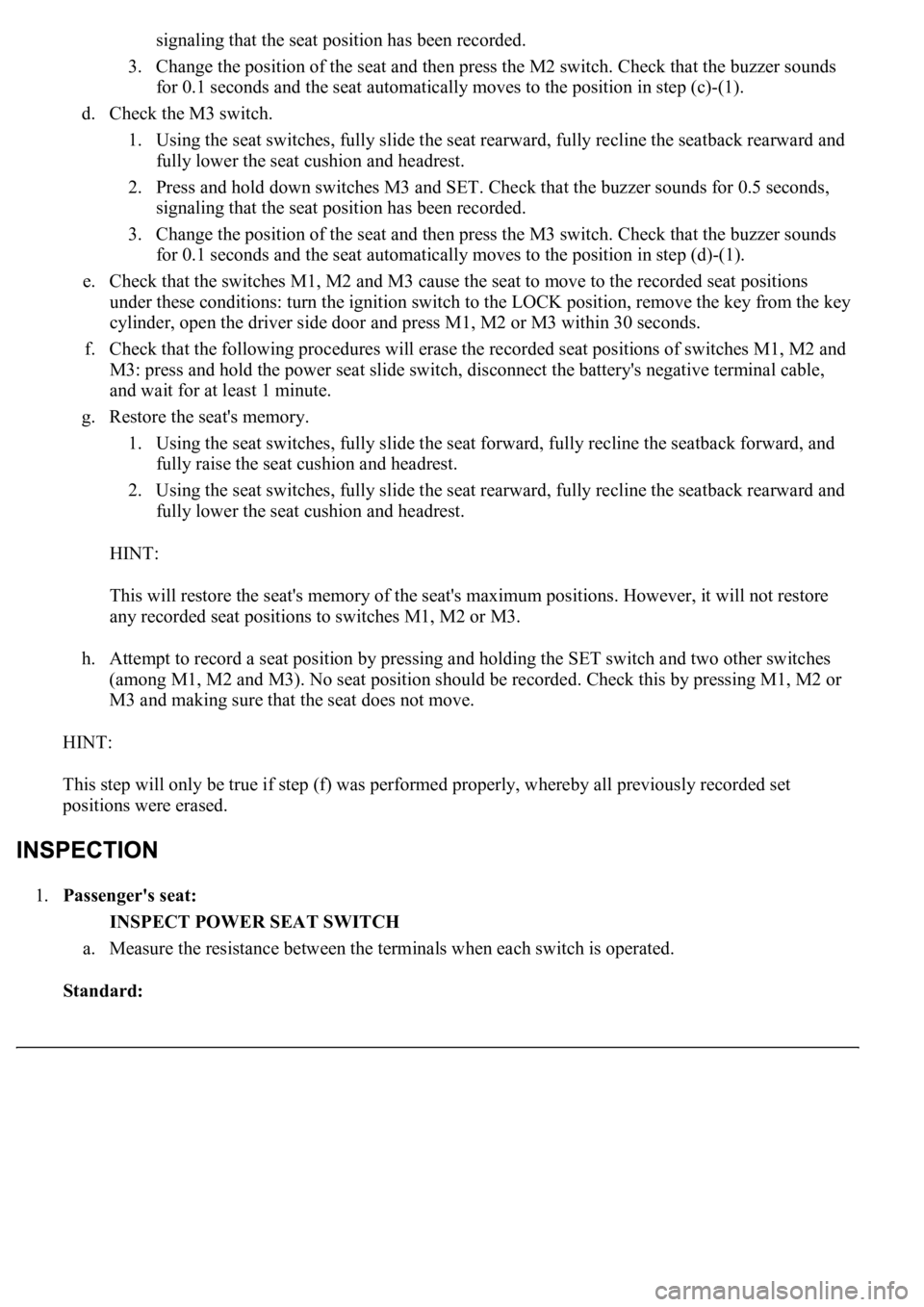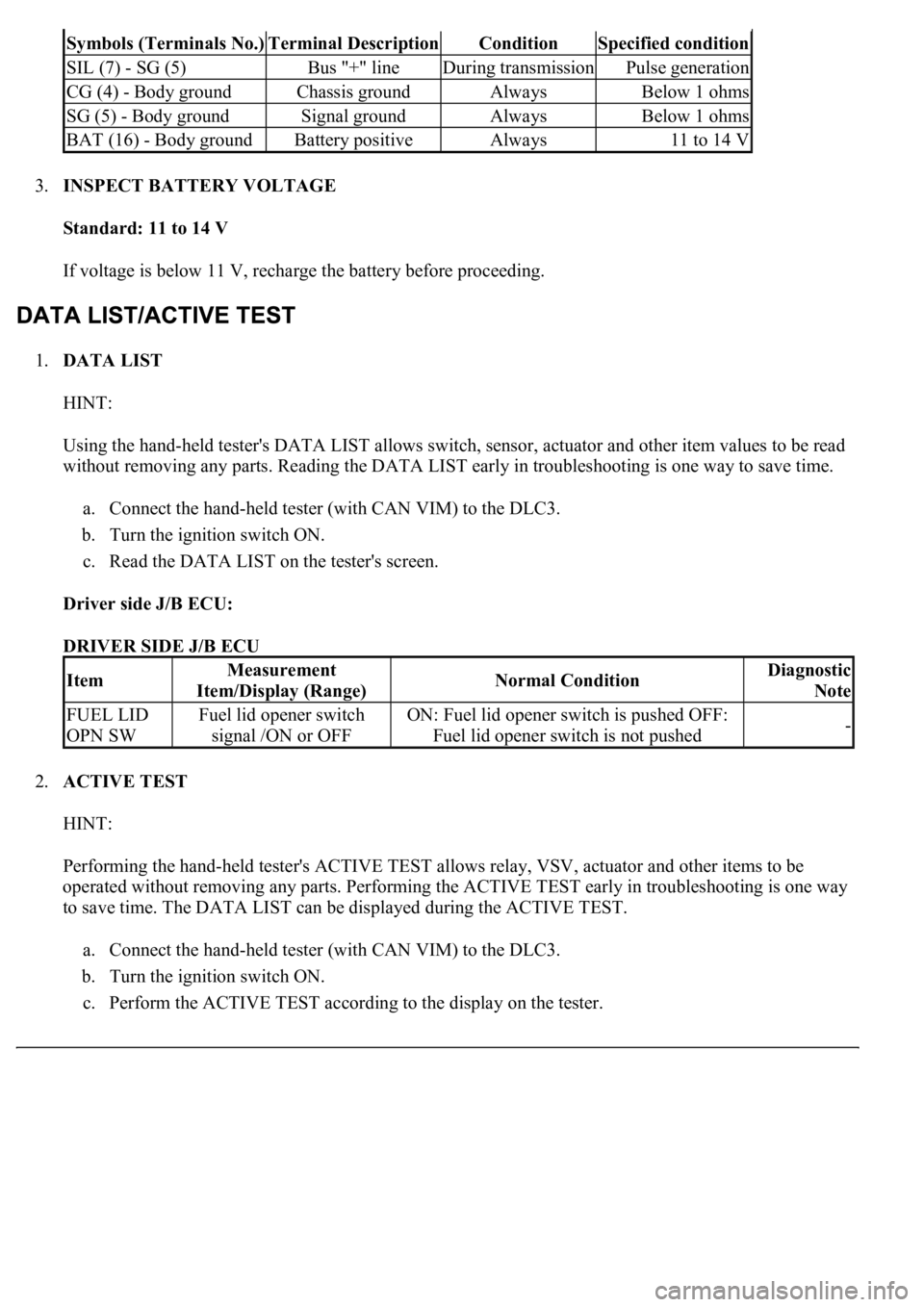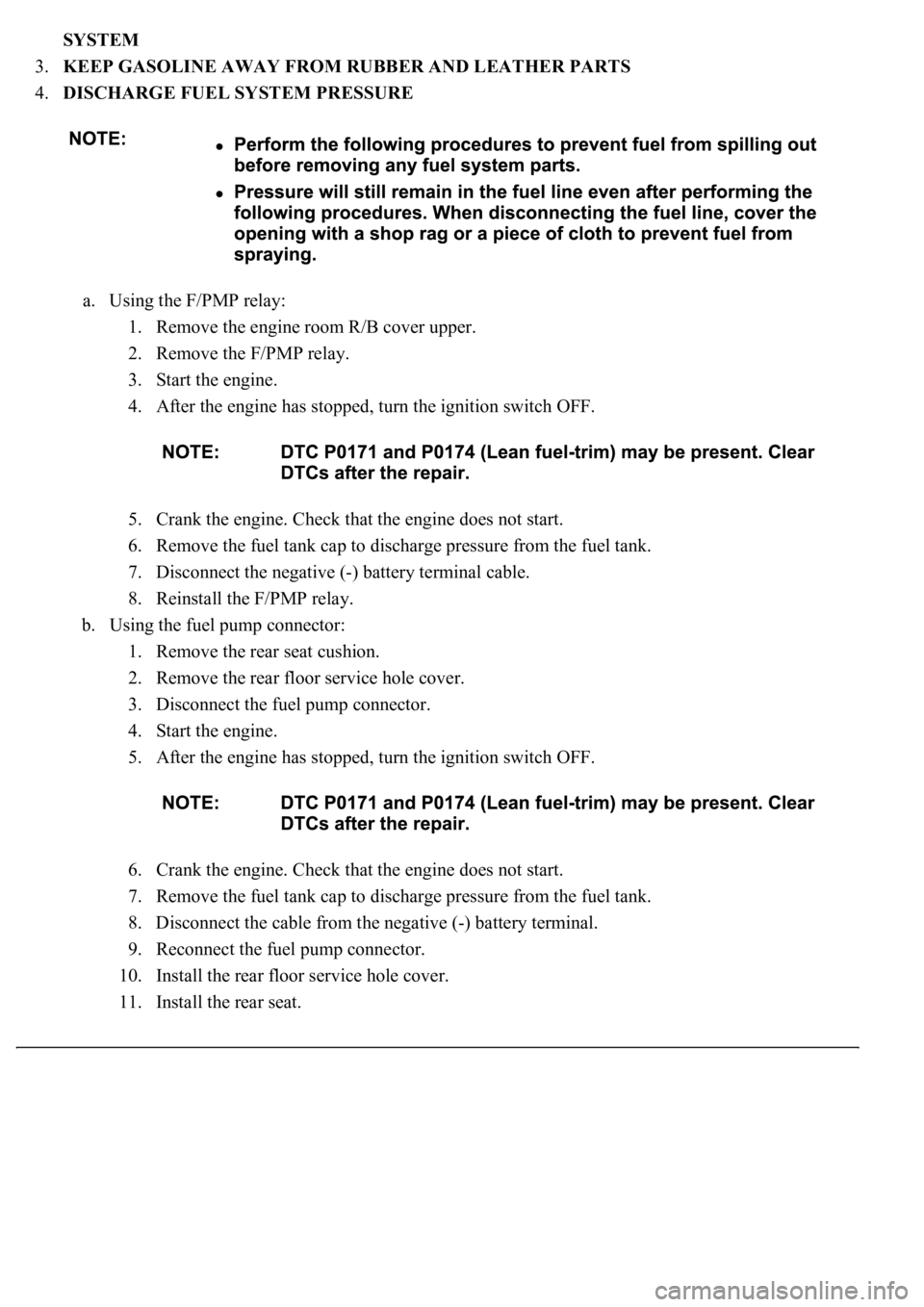Page 3971 of 4500

signaling that the seat position has been recorded.
3. Change the position of the seat and then press the M2 switch. Check that the buzzer sounds
for 0.1 seconds and the seat automatically moves to the position in step (c)-(1).
d. Check the M3 switch.
1. Using the seat switches, fully slide the seat rearward, fully recline the seatback rearward and
fully lower the seat cushion and headrest.
2. Press and hold down switches M3 and SET. Check that the buzzer sounds for 0.5 seconds,
signaling that the seat position has been recorded.
3. Change the position of the seat and then press the M3 switch. Check that the buzzer sounds
for 0.1 seconds and the seat automatically moves to the position in step (d)-(1).
e. Check that the switches M1, M2 and M3 cause the seat to move to the recorded seat positions
under these conditions: turn the ignition switch to the LOCK position, remove the key from the key
cylinder, open the driver side door and press M1, M2 or M3 within 30 seconds.
f. Check that the following procedures will erase the recorded seat positions of switches M1, M2 and
M3: press and hold the power seat slide switch, disconnect the battery's negative terminal cable,
and wait for at least 1 minute.
g. Restore the seat's memory.
1. Using the seat switches, fully slide the seat forward, fully recline the seatback forward, and
fully raise the seat cushion and headrest.
2. Using the seat switches, fully slide the seat rearward, fully recline the seatback rearward and
fully lower the seat cushion and headrest.
HINT:
This will restore the seat's memory of the seat's maximum positions. However, it will not restore
any recorded seat positions to switches M1, M2 or M3.
h. Attempt to record a seat position by pressing and holding the SET switch and two other switches
<000b0044005000520051004a000300300014000f0003003000150003004400510047000300300016000c0011000300310052000300560048004400570003005300520056004c0057004c0052005100030056004b00520058004f0047000300450048000300
550048004600520055004700480047001100030026004b0048[ck this by pressing M1, M2 or
M3 and making sure that the seat does not move.
HINT:
This step will only be true if step (f) was performed properly, whereby all previously recorded set
positions were erased.
1.Passenger's seat:
INSPECT POWER SEAT SWITCH
a. Measure the resistance between the terminals when each switch is operated.
Standard:
Page 4079 of 4500
Fig. 9: Identifying Terminals Of ECU - Luggage Room J/B Assy (Luggage Room J/B ECU)
Courtesy of TOYOTA MOTOR SALES, U.S.A., INC.
a. Disconnect the LA, LF and LL J/B, and L12 and L14 ECU connectors.
b. Measure the voltage and resistance of the wire harness side connectors.
Standard:
TERMINAL DESCRIPTION AND SPECIFIED CONDITION
Symbols (Terminal
No.)
Wiring Color
Terminal
Description
Condition
Specified
Condition
MPX-B (LF-12) -
Body groundSB - Body
ground+B (MPX-B) power
supplyAlways10 to 14 V
MPX-IG (LF-13) -
Body groundL - Body ground+B (MPX-IG)
power supplyIgnition switch 1:
OFF --> 2: ON1: Below 1 V -->
2: 10 to 14 V
HIC (LL-1) - Body
groundB-W - Body
ground+B (MPX-B) power
supplyAlways10 to 14 V
P-GND (LA-5) -
Body groundW-B - Body
groundGroundAlwaysBelow 1 ohms
SG (L14-5) - Body
groundW-B - Body
groundGroundAlwaysBelow 1 ohms
Page 4081 of 4500
Fig. 11: Identifying Terminals Of DLC3
Courtesy of TOYOTA MOTOR SALES, U.S.A., INC.
2.CHECK DLC3
The vehicle's ECU uses the ISO 15765-4 communication protocol. The terminal arrangement of the
DLC3 complies with SAE J1962 and matches the ISO 15765-4 format.
HINT:
Connect the cable of the hand-held tester (with CAN VIM) to the DLC3, turn the ignition switch ON and
attempt to use the hand-held tester. If the screen displays UNABLE TO CONNECT TO VEHICLE, a
problem exists in the vehicle side or the tester side.
If the communication is normal when the tester is connected to another vehicle, inspect the DLC3 on the
original vehicle.
If the communication is still impossible when the tester is connected to another vehicle, the problem is
probably in the tester itself. Consult the Service Department listed in the tester's instruction manual.
TERMINAL DESCRIPTION AND SPECIFIED CONDITION
Page 4082 of 4500

3.INSPECT BATTERY VOLTAGE
Standard: 11 to 14 V
If voltage is below 11 V, recharge the battery before proceeding.
1.DATA LIST
HINT:
Using the hand-held tester's DATA LIST allows switch, sensor, actuator and other item values to be read
without removing any parts. Reading the DATA LIST early in troubleshooting is one way to save time.
a. Connect the hand-held tester (with CAN VIM) to the DLC3.
b. Turn the ignition switch ON.
c. Read the DATA LIST on the tester's screen.
Driver side J/B ECU:
DRIVER SIDE J/B ECU
2.ACTIVE TEST
HINT:
Performing the hand-held tester's ACTIVE TEST allows relay, VSV, actuator and other items to be
operated without removing any parts. Performing the ACTIVE TEST early in troubleshooting is one way
to save time. The DATA LIST can be displayed during the ACTIVE TEST.
a. Connect the hand-held tester (with CAN VIM) to the DLC3.
b. Turn the ignition switch ON.
c. Perform the ACTIVE TEST accordin
g to the display on the tester.
Symbols (Terminals No.)Terminal DescriptionConditionSpecified condition
SIL (7) - SG (5)Bus "+" lineDuring transmissionPulse generation
CG (4) - Body groundChassis groundAlwaysBelow 1 ohms
SG (5) - Body groundSignal groundAlwaysBelow 1 ohms
BAT (16) - Body groundBattery positiveAlways11 to 14 V
ItemMeasurement
Item/Display (Range)Normal ConditionDiagnostic
Note
FUEL LID
OPN SWFuel lid opener switch
signal /ON or OFFON: Fuel lid opener switch is pushed OFF:
Fuel lid opener switch is not pushed-
Page 4085 of 4500
INSPECTION PROCEDURE
1.INSPECT FUSE (MPX-B3, MPX-IG and AM1, D/C CUT)
a. Remove the MPX-B3 fuse from the passenger side J/B.
b. Remove the MPX-IG and AM1 fuse from the driver side J/B.
c. Remove the D/C CUT fuse from the FL block assy.
d. Measure the resistance.
Standard: Below 1 ohms
NG: REPLACE FUSE
OK: GO TO NEXT STEP
2.CHECK WIRE HARNESS (LUGGAGE ROOM J/B ECU - BATTERY AND BODY GROUND)
a. Disconnect the LA, LF and LL J/B, and L14 ECU connectors.
b. Measure the resistance and voltage of the wire harness side connectors.
Standard:
TESTER CONNECTION AND SPECIFIED CONDITION
Tester connectionConditionSpecified condition
LF-13 (MPX-IG) - Body groundIgnition switch ON10 to 14 V
LF-12 (MPX-B) - Body groundAlways10 to 14 V
LL-1 (L-O/C (P)) - Body groundAlways10 to 14 V
LA-5 (P-GND) - Body groundAlwaysBelow 1 ohms
L14-5 (SG) - Body groundAlwaysBelow 1 ohms
Page 4103 of 4500

SYSTEM
3.KEEP GASOLINE AWAY FROM RUBBER AND LEATHER PARTS
4.DISCHARGE FUEL SYSTEM PRESSURE
a. Using the F/PMP relay:
1. Remove the engine room R/B cover upper.
2. Remove the F/PMP relay.
3. Start the engine.
4. After the engine has stopped, turn the ignition switch OFF.
5. Crank the engine. Check that the engine does not start.
6. Remove the fuel tank cap to discharge pressure from the fuel tank.
7. Disconnect the negative (-) battery terminal cable.
8. Reinstall the F/PMP relay.
b. Using the fuel pump connector:
1. Remove the rear seat cushion.
2. Remove the rear floor service hole cover.
3. Disconnect the fuel pump connector.
4. Start the engine.
5. After the engine has stopped, turn the ignition switch OFF.
6. Crank the engine. Check that the engine does not start.
7. Remove the fuel tank cap to discharge pressure from the fuel tank.
8. Disconnect the cable from the negative (-) battery terminal.
9. Reconnect the fuel pump connector.
10. Install the rear floor service hole cover.
11. Install the rear seat.
Page 4112 of 4500
Fig. 14: Connecting Hand-Held Tester (With CAN VIM) To DLC3 Connector Terminal
Courtesy of TOYOTA MOTOR SALES, U.S.A., INC.
3. Select the ACTIVE TEST mode on the hand-held tester.
HINT:
Please refer to the hand-held tester operator's manual for further details.
4. Check that there are no leaks from any part of the fuel system.
5. Turn the ignition switch LOCK.
6. Disconnect the hand-held tester from the DLC3.
ON-VEHICLE INSPECTION
1.CHECK FUEL PUMP OPERATION
a. Connect the hand-held tester (with CAN VIM) to the DLC3.
b. Turn the ignition switch ON and push the hand-held tester main switch ON.
Do not start the engine.
Page 4113 of 4500
Fig. 15: Connecting Hand-Held Tester DLC3
Courtesy of TOYOTA MOTOR SALES, U.S.A., INC.
c. Select the ACTIVE TEST mode on the hand-held tester.
d. Please refer to the hand-held tester operator's manual for further details.
e. Check that there is pressure in the fuel inlet hose from the fuel filter.
HINT:
If there is fuel pressure, you will hear the sound of fuel flowing. If there is no pressure, check the
fusible link, fuses, EFI MAIN relay, fuel pump, ECM and wiring connections.
f. Turn the ignition switch to LOCK.
g. Disconnect the hand-held tester from the DLC3.
2.CHECK FUEL PRESSURE
a. Check that the battery positive voltage is above 12 V.
b. Disconnect the negative (-) terminal cable from the battery.
c. Remove the fuel pressure pulsation damper from the RH delivery pipe (see REPLACEMENT
).
d. Install the fuel pipe sub-ass
y No. 2 and SST (pressure gauge) to the delivery pipe with the 3 lower